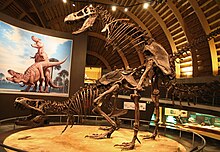This article possibly contains original research. (March 2023) |

Exhibit design (or exhibition design[1]) is the process of developing an exhibit—from a concept through to a physical, three-dimensional exhibition. It is a continually evolving field, drawing on innovative, creative, and practical solutions to the challenge of developing communicative environments that 'tell a story' in a three-dimensional space.[2]
There are many people who collaborate to design exhibits such as directors, Curators, exhibition designers, and technicians. These positions have great importance because how they design will affects how people learn.[3] Learning is a byproduct of attention, so first the designers must capture the visitors attention.[4]
A good exhibition designer will consider the whole environment in which a story is being interpreted rather than just concentrating on individual exhibits. Some other things designers must consider are the space allotted for the display, precautions to protect what is being displayed, and what they are displaying. For example a painting, a mask, and a diamond will not be displayed the same way. Taking into account with artifacts culture and history is also important because every time the artifact is displayed in a new context it reinterprets them [5]
- ^ Dernie, David (2006). Exhibition Design. W. W. Norton & Company. ISBN 978-0-393-73211-5.
- ^ MA Design for Exhibition and Museum Archived 2018-04-12 at the Wayback Machine, University of Lincoln, UK.
- ^ Edwards, Elise Coralie (2007). "The Future for Curators". Papers from the Institute of Archaeology. 18 (1): 98–114. doi:10.5334/296 – via DOAJ Directory of Open Access Journals.
- ^ Bitgood, Stephen (2013). Attention and Value: Keys to understanding Museum Visitors. Taylor & Francis Group.
- ^ Schittich, Christian (2009). Exhibition and Displays: Museum Design Concepts, Brand Presentation, Trade Show Design. Basel: Birkhauser.